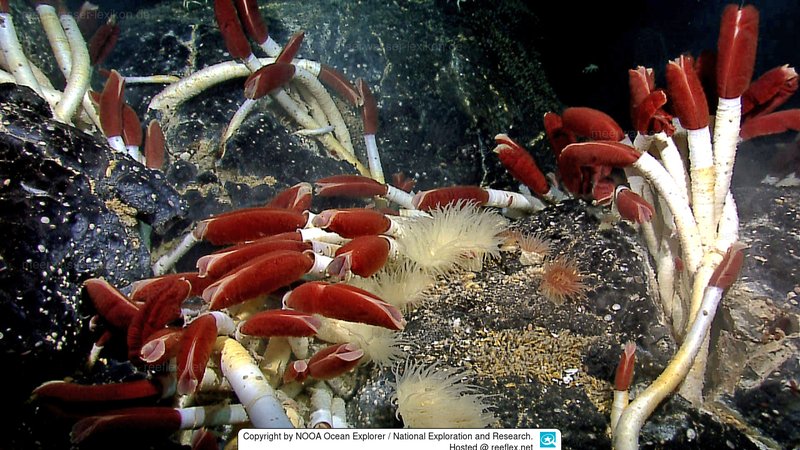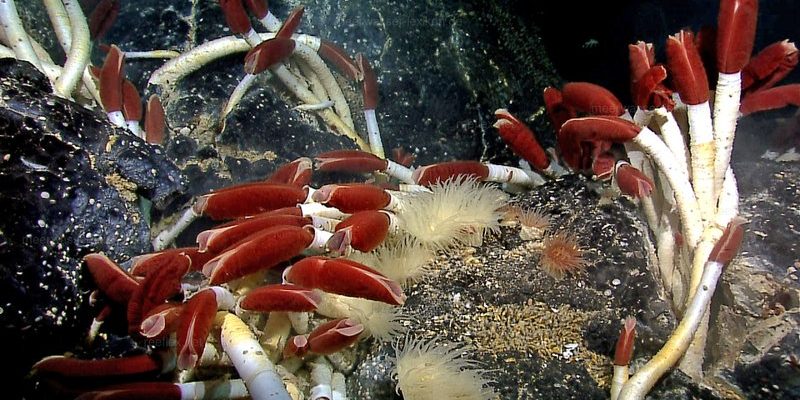
Imagine a tube worm as an underwater skyscraper, reaching heights of almost eight feet. They’re not your usual worm, either; they don’t have mouths or digestive systems like most animals. Instead, they rely on a symbiotic relationship with bacteria that convert the chemicals emitted by these hydrothermal vents into energy. This astonishing adaptation has sparked curiosity among scientists and researchers, leading to questions about their survival and the potential for studying or farming them in controlled environments.
Understanding Riftia Pachyptila
Riftia pachyptila are chemosynthetic organisms, meaning they survive without sunlight. Instead of munching on organic material, they thrive on hydrogen sulfide, which is abundant around hydrothermal vents. Their tube-like structure provides protection from the harsh underwater environment, allowing them to remain anchored to the ocean floor.
These creatures are typically found at depths of about 2,500 meters (or around 8,200 feet) in the eastern Pacific Ocean. The unique ecosystems around these vents are rich in nutrients, creating a haven for various marine life. Riftia pachyptila’s fascinating adaptations, like their ability to process toxic chemicals, make them a subject of interest for marine biologists and environmental scientists alike.
You might be wondering why these tube worms are so important. Aside from their role in the deep-sea ecosystem, studying them can provide insights into biotechnology, potentially helping in areas like biofuels and environmental sustainability. With such potential, the idea of studying Riftia pachyptila in captivity becomes even more compelling.
The Challenges of Keeping Riftia Pachyptila in Captivity
Keeping Riftia pachyptila alive in captivity presents significant challenges. These worms are accustomed to extreme pressures, high temperatures, and unique chemical environments that are hard to replicate. Scientists must create a habitat that closely mimics their natural surroundings to ensure their survival.
One major hurdle is maintaining the right levels of hydrogen sulfide. Too much can be toxic, while too little can starve them as their symbiotic bacteria depend on it for energy. Additionally, recreating the high-pressure conditions of the deep sea requires specialized equipment that can be costly and complex.
Here’s the thing: scientists have attempted to keep these worms alive in aquariums, but the results have been mixed. Successful studies have often relied on advanced systems that continually supply nutrients and manage waste. This level of care can be labor-intensive and may not be feasible for long-term research or farming.
Potential Benefits of Farming Riftia Pachyptila
If we could overcome the challenges of keeping Riftia pachyptila in captivity, the potential benefits could be enormous. For one, farming this species could lead to major breakthroughs in biotechnology. The bacteria that live within these worms can produce energy from toxic substances, which might be harnessed for clean energy solutions.
Additionally, studying Riftia pachyptila in controlled environments allows scientists to monitor their growth rates, breeding patterns, and responses to environmental changes. This knowledge could provide insights into how other marine organisms respond to climate change and pollution, helping us develop better conservation strategies.
Moreover, if farming these organisms becomes viable, it could create new avenues for economic development. Imagine sustainable farming practices that provide jobs and resources while also contributing to scientific research. The possibilities are exciting!
Current Research on Riftia Pachyptila
Many researchers are committed to studying Riftia pachyptila and continually pushing the boundaries of what we know. Some projects aim to explore their genomics—the study of their DNA—to understand the unique adaptations that allow them to thrive in extreme environments. By decoding their genetic makeup, scientists can uncover natural processes that may have applications beyond marine biology.
For example, understanding how these tube worms manage stress could help in developing stress-resistant crops or even improving human health. There are also ongoing efforts to explore the relationships between Riftia pachyptila and other marine organisms in their ecosystems. This research can shed light on the intricate networks that sustain life in the deep sea.
It’s important to note that while promising, these studies often face ethical and logistical challenges. Balancing research with environmental conservation is crucial, as disturbing natural habitats can have unforeseen consequences.
Future Prospects: Can We Sustainably Farm Riftia Pachyptila?
The dream of farming Riftia pachyptila isn’t exactly straightforward, but it’s not completely out of reach either. As technology advances, researchers are exploring more sustainable and innovative methods for keeping these specialized organisms alive and thriving. For instance, advancements in closed-loop systems could help create environments that replicate their natural habitat without depleting ocean resources.
Another exciting possibility is the use of bioreactors—essentially, high-tech fish tanks designed to mimic natural conditions. By utilizing cutting-edge technology, scientists can create a self-sustaining ecosystem that resembles the deep-sea environment while offering controlled conditions for research and farming.
However, with any advances, it’s essential to proceed with caution. Ensuring that farming methods do not negatively impact existing ecosystems should always be a priority. Striking a balance between scientific curiosity and environmental responsibility is key to any potential farming effort.
In summary, Riftia pachyptila are remarkable organisms that challenge our understanding of life and present exciting opportunities for research and biotechnology. While keeping them in captivity comes with significant challenges, the potential benefits of studying and possibly farming these tube worms are immense.
As scientists continue their exploration of these deep-sea wonders, we can look forward to learning more about their unique adaptations and the secrets of the oceanic ecosystem. Who knows? One day, we might successfully farm these giant tube worms, unlocking new scientific advancements while maintaining a healthy relationship with our planet. The journey to understanding Riftia pachyptila is just beginning, and it’s full of possibilities!

